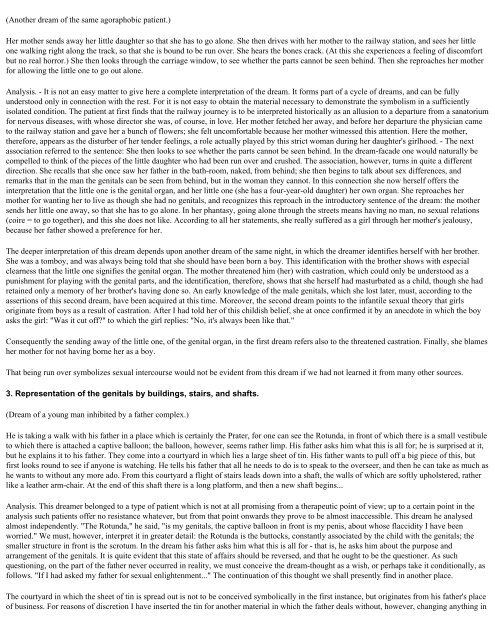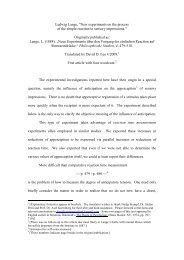The Interpretation Of Dreams Sigmund Freud (1900) PREFACE
The Interpretation Of Dreams Sigmund Freud (1900) PREFACE
The Interpretation Of Dreams Sigmund Freud (1900) PREFACE
Create successful ePaper yourself
Turn your PDF publications into a flip-book with our unique Google optimized e-Paper software.
(Another dream of the same agoraphobic patient.)<br />
Her mother sends away her little daughter so that she has to go alone. She then drives with her mother to the railway station, and sees her little<br />
one walking right along the track, so that she is bound to be run over. She hears the bones crack. (At this she experiences a feeling of discomfort<br />
but no real horror.) She then looks through the carriage window, to see whether the parts cannot be seen behind. <strong>The</strong>n she reproaches her mother<br />
for allowing the little one to go out alone.<br />
Analysis. - It is not an easy matter to give here a complete interpretation of the dream. It forms part of a cycle of dreams, and can be fully<br />
understood only in connection with the rest. For it is not easy to obtain the material necessary to demonstrate the symbolism in a sufficiently<br />
isolated condition. <strong>The</strong> patient at first finds that the railway journey is to be interpreted historically as an allusion to a departure from a sanatorium<br />
for nervous diseases, with whose director she was, of course, in love. Her mother fetched her away, and before her departure the physician came<br />
to the railway station and gave her a bunch of flowers; she felt uncomfortable because her mother witnessed this attention. Here the mother,<br />
therefore, appears as the disturber of her tender feelings, a role actually played by this strict woman during her daughter's girlhood. - <strong>The</strong> next<br />
association referred to the sentence: She then looks to see whether the parts cannot be seen behind. In the dream-facade one would naturally be<br />
compelled to think of the pieces of the little daughter who had been run over and crushed. <strong>The</strong> association, however, turns in quite a different<br />
direction. She recalls that she once saw her father in the bath-room, naked, from behind; she then begins to talk about sex differences, and<br />
remarks that in the man the genitals can be seen from behind, but in the woman they cannot. In this connection she now herself offers the<br />
interpretation that the little one is the genital organ, and her little one (she has a four-year-old daughter) her own organ. She reproaches her<br />
mother for wanting her to live as though she had no genitals, and recognizes this reproach in the introductory sentence of the dream: the mother<br />
sends her little one away, so that she has to go alone. In her phantasy, going alone through the streets means having no man, no sexual relations<br />
(coire = to go together), and this she does not like. According to all her statements, she really suffered as a girl through her mother's jealousy,<br />
because her father showed a preference for her.<br />
<strong>The</strong> deeper interpretation of this dream depends upon another dream of the same night, in which the dreamer identifies herself with her brother.<br />
She was a tomboy, and was always being told that she should have been born a boy. This identification with the brother shows with especial<br />
clearness that the little one signifies the genital organ. <strong>The</strong> mother threatened him (her) with castration, which could only be understood as a<br />
punishment for playing with the genital parts, and the identification, therefore, shows that she herself had masturbated as a child, though she had<br />
retained only a memory of her brother's having done so. An early knowledge of the male genitals, which she lost later, must, according to the<br />
assertions of this second dream, have been acquired at this time. Moreover, the second dream points to the infantile sexual theory that girls<br />
originate from boys as a result of castration. After I had told her of this childish belief, she at once confirmed it by an anecdote in which the boy<br />
asks the girl: "Was it cut off?" to which the girl replies: "No, it's always been like that."<br />
Consequently the sending away of the little one, of the genital organ, in the first dream refers also to the threatened castration. Finally, she blames<br />
her mother for not having borne her as a boy.<br />
That being run over symbolizes sexual intercourse would not be evident from this dream if we had not learned it from many other sources.<br />
3. Representation of the genitals by buildings, stairs, and shafts.<br />
(Dream of a young man inhibited by a father complex.)<br />
He is taking a walk with his father in a place which is certainly the Prater, for one can see the Rotunda, in front of which there is a small vestibule<br />
to which there is attached a captive balloon; the balloon, however, seems rather limp. His father asks him what this is all for; he is surprised at it,<br />
but he explains it to his father. <strong>The</strong>y come into a courtyard in which lies a large sheet of tin. His father wants to pull off a big piece of this, but<br />
first looks round to see if anyone is watching. He tells his father that all he needs to do is to speak to the overseer, and then he can take as much as<br />
he wants to without any more ado. From this courtyard a flight of stairs leads down into a shaft, the walls of which are softly upholstered, rather<br />
like a leather arm-chair. At the end of this shaft there is a long platform, and then a new shaft begins...<br />
Analysis. This dreamer belonged to a type of patient which is not at all promising from a therapeutic point of view; up to a certain point in the<br />
analysis such patients offer no resistance whatever, but from that point onwards they prove to be almost inaccessible. This dream he analysed<br />
almost independently. "<strong>The</strong> Rotunda," he said, "is my genitals, the captive balloon in front is my penis, about whose flaccidity I have been<br />
worried." We must, however, interpret it in greater detail: the Rotunda is the buttocks, constantly associated by the child with the genitals; the<br />
smaller structure in front is the scrotum. In the dream his father asks him what this is all for - that is, he asks him about the purpose and<br />
arrangement of the genitals. It is quite evident that this state of affairs should be reversed, and that he ought to be the questioner. As such<br />
questioning, on the part of the father never occurred in reality, we must conceive the dream-thought as a wish, or perhaps take it conditionally, as<br />
follows. "If I had asked my father for sexual enlightenment..." <strong>The</strong> continuation of this thought we shall presently find in another place.<br />
<strong>The</strong> courtyard in which the sheet of tin is spread out is not to be conceived symbolically in the first instance, but originates from his father's place<br />
of business. For reasons of discretion I have inserted the tin for another material in which the father deals without, however, changing anything in



